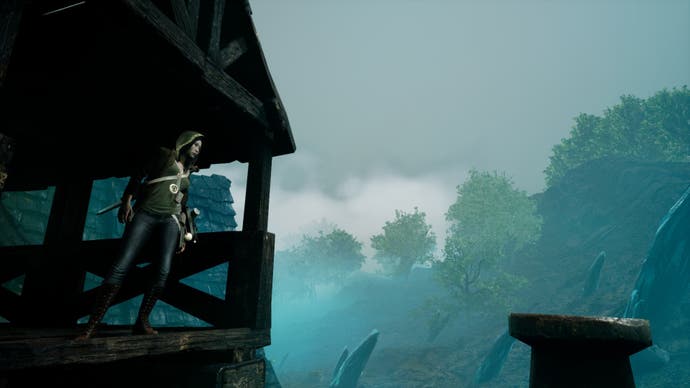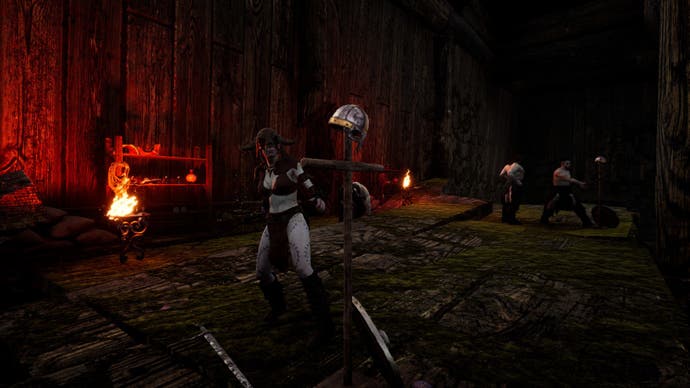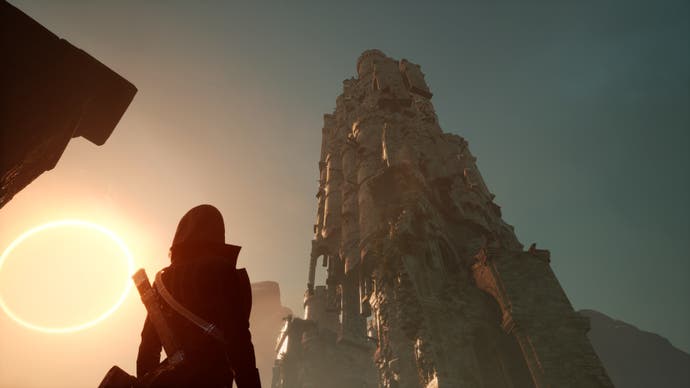Dream Cycle review – chaotic procgen spellcraft from one of Tomb Raider’s original creators
From Lara with Lovecraft.
Dream Cycle is the first game I've played that puts a fresh spin on Blink, Dishonored's widely imitated short-range teleport spell. Admittedly, it's less about the ability in itself, than how it works with and against the game’s sporadically coherent terrain. In Dishonored, Blink is sort of headshots but for movement, snapping you between points with toe-curling specificity. It takes the stodge out of vertical exploration and edits plodding stealth into a series of catlike pounces. It plays that role in Dream Cycle, too, especially when combined with levitation and silenced SMGs. But it's also, here, a means of spelunking through a world that doesn’t quite want to be explored.
If you've done any caving yourself, you'll be familiar with the mingled temptation and dread when you spot another chamber through a gap you're not sure you can fit through. A beautifully banded sandstone channel, screened by stalactites. A hint of crystal in the dark, or the seductive glimmer of running water. Can you find a way to that glimmer, and rather more importantly, can you make it out again? Dream Cycle is made up of horribly tantalising spaces like these. It’s a third- and first-person action-adventure based on Lovecraft’s own “dream cycle” stories, set in procedurally generated biomes that consist of small, ruined overworlds and a concluding, separately loaded dungeon. You play Morgan Carter (yes, as in Randolph) - a young mage who’s as handy with a sword or pistol as she is a bolt of lightning. She’s searching the Dreamlands for her friend Erin, one of many victims of a mysterious sleeping sickness.
The procedural generation is highly erratic at the time of writing, often smashing the game's prefabbed structures together so ferociously that key doors and windows are buried. But you can generally Blink - sorry, “Shadow Step” to gain access, flowing through fist-sized holes into eerie aggregations of soil and stone. Can you make it out again? Sometimes, the answer is no. Dream Cycle is more forgiving about magic than Dishonored – use a spell, and you can regain the mana providing you don't fire off another immediately – but it's still possible to exhaust your mana vials and maroon yourself while tele-hopping around structures that evoke Cubism as much as they do European castles or Aztec temples.
Which might not sound very fun, and indeed, I can't recommend Dream Cycle as it stands. The game's 1.0 launch seems to be more about financial necessity than completeness, with bugs that spawn you off map or freeze up the controls. Technical issues aside, I’m not very excited by its campaign rhythm of replaying biomes with more/tougher enemies for higher-level gear, keys to new regions, and memory fragments that further Morgan’s search for Erin. But Dream Cycle’s crazed and uneven gamespace is more beguiling than many of the fully intact virtual worlds I’ve explored - and unlike, say, the comparably messy Underworld: Ascendant, its movement systems are gratifying enough that you actually want to delve deeper.
Dream Cycle is the work of a tiny team led by Toby Gard, and exists in mutually transformative dialogue with the game Gard is best known for: the original Tomb Raider from 1996. When I think of Tomb Raider 26 years on I think of an overwhelming need for precision born of an era when roaming a 3D environment was an alien, experimental, unwieldy pursuit. Where today's third-person blockbusters let you sit back and enjoy the ride, here you must calculate every jump, weigh every footfall. There’s no face-saving auto-mantle, no semi-automatic camera to aim you at the next platform, no checkpointing, no graded analog input, no glowing waypoint or breadcrumb trail. You spot the routes and hit all the buttons with perfect timing or you perish.

Rather than rendering Tomb Raider “obsolete”, the additions and tune-ups of games like Prince of Persia: Sands of Time, Assassin's Creed and, indeed, the Tomb Raider reboots have only made the older game stranger, more thrilling, more essential. In being devoid of now-customary user-friendly features, its ruins and caverns feel all the more like, well, ruins and caverns - the product of inhuman and unsympathetic erosion and tectonic forces, whatever their resemblance to human-designed edifices. This world might be solvable, but it’s never accommodating. There’s a pervasive incompatibility between player and simulation that has only intensified as the genre has evolved: not just the constant prospect of Lara meeting a sticky end, but a kind of ambient dislike of the player being there at all.
As Gard has explained elsewhere, Dream Cycle is an attempt to build a modern action-adventure on a shoe-string budget, using procgen to do some of the heavy lifting. But it often feels like an attempt to reconcile the fool-proof traversal of Tomb Raider's slicker successors with the shock of rediscovering Tomb Raider's relatively unreceptive world. On the one hand, Morgan is to ‘90s Lara Croft what Naruto is to a hoover: she can glide, air dash and perform super-powered ledge vaults, all the better to get the drop on befuddled outcrops of melee, ranged and magical opponents. Even before you plug in perks that (for example) extend your gliding time, she can swarm up a tower exterior in seconds, and you’d certainly never get towers like these in classic Tomb Raider. But Dream Cycle's misbegotten landscapes have the same recalcitrant, alien vibe as Gard’s reputation-making creation, their dark materials compressed into architecture that doesn't quite welcome your intervention, and is all the more mesmerising for it.

I say “compressed”, but the buildings are often more like body cells caught mid-duplication. I'm not sure I've ever climbed a complete staircase in Dream Cycle: they're always trying to disentangle themselves from other staircases. I have a screenshot album full of archways that feed into kaleidoscopic snakepits of other archways. It’s not always clear which fixtures are interior or exterior: I’ve found jaunty vegetable racks mounted on frozen outer walls, and pillared thrones grandly facing into ditches. Elsewhere, waterfalls spill from empty air and hammered planks form haphazard paths around doubled-up columns of floating rock. I can fathom the logic behind those planks, their spacing allowing a mana-less Morgan to ascend by jumping and vaulting. But I can’t explain the roofs that have roofs, or the balustrades gnashing together like angry teeth.
The fascination of these spaces is that they don't feel made for me. They certainly aren't made for the convenience of Morgan's enemies - some found squatting grumpily by campfires wedged at 45 degree angles, others crammed like woodlice beneath huge slabs of hovering foundation. It’s no wonder they attack her on sight: if you had to live inside one of Pablo Picasso’s drunker paintings, you wouldn’t feel very hospitable either. Dungeon bosses, spawned by poking something ominous like a golden statue, get the worst of it: some are as large as houses, and pretty much trap themselves in the geography the second they try anything fancy, like walking towards you.
The other way of justifying Dream Cycle’s eccentric procgen, of course, is that this is yet another Lovecraft story concerned with the nth-dimensional horrors that lurk beyond the twitching bedroom curtains of the human consciousness. The dreamworld is supposed to be incomprehensible, then, though as is tradition for Lovecraft adaptations, it balances the haunting prospect of “impossible geometry” with over-familiar monster design, turgid exposition (you’ll find three-page excerpts from stories like The White Ship) and a fundamental cheesiness (Morgan is given to sarky notes-to-self).

Some of the terrain inconsistencies are more deliberate: as in Control and Returnal, you’ll stumble on objects from distant times and places, such as televisions and telephone booths, which tie into the inevitable broader conspiracy surrounding Erin’s disappearance. (Other anachronistic level pieces serve as dropzones for tastier weapons, like lightning pendants or sniper rifles.) The game also keeps you guessing about the time of day. In certain areas, the unseen sun crosses the sky in moments, raking the vegetation like a searchlight - an echo of Lovecraft’s great influence, William Hope Hodgson’s The House on the Borderland. But I think the procedural terrain’s charm and threat are bigger than any nod to Cthulhu and his ilk, inasmuch as Lovecraft’s own cosmic vistas grow less oppressive the more they’re associated with various big-name squid-faced monsters. Rather than schemes of the Old Ones, Dream Cycle’s environments feel like symptoms of violent creative forces that only accidentally make room for the player.
Given that Dream Cycle is still basically an Early Access game in all but name, I can imagine a couple of directions in terms of updates. On the one hand, with a lot more QA this could be a solid mage combat sim - a freeform, aerially-minded brawler that rides Spellbreak's coat tails in order to steal Forspoken's thunder. The controls are well thought out, with abilities selected and performed by holding and releasing a controller bumper, and there's real theatre to the spells, which range from pleasingly hefty, arcing fireballs to a kamehameha beam that whites out the screen.
Enemies aren’t always sitting ducks, either. While hopelessly undone by the geometry, their saving grace is that they, too, can teleport, disintegrating and reappearing like Death Eaters set to Shuffle. It's more for spectacle than utility, but it's another incentive for you to grab some airtime, rather than hanging back with a longbow or wading in with a shotgun. The non-magical melee and ranged combat are less enthralling - foes have weak points that allow for instant takedowns, but random flailing and dodging will often do the job just as speedily, especially if your target gets stuck in a table..
Building on all this and taming the procgen would be the safer path for Dream Cycle in terms of Steam reviews. All the same, I’d prefer to play an updated version that actively enhances the weirdness of the terrain algorithms - a game where the point is less killing and grinding, more gliding, blinking and vaulting through ever-odder and less pliable combinations of masonry and geology. Can you make it out again? We too often grade procedural generation systems in terms of whether they conjure something that feels properly “hand-made”. I think this disregards the thrill and lingering disquiet of navigating a space that is busily following its own rules, without regard for the player caught in the strata.


